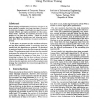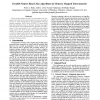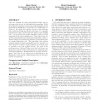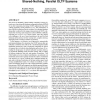6 search results - page 1 / 2 » A Taxonomy and Performance Model of Data Skew Effects in Par... |
VLDB
1991
ACM
13 years 8 months ago
1991
ACM
Recent work on parallel joins and data skew has concentrated on algorithm design without considering the causes and chara.cteristics of data. skew itself. Existming ana.lyt,ic mod...
VLDB
1991
ACM
13 years 8 months ago
1991
ACM
Shared nothing multiprocessor archit.ecture is known t.obe more scalable to support very large databases. Compared to other join strategies, a hash-ba9ed join algorithm is particu...
ICDE
1996
IEEE
14 years 6 months ago
1996
IEEE
Three pointer-based parallel join algorithms are presented and analyzed for environments in which secondary storage is made transparent to the programmer through memory mapping. B...
SIGMOD
2011
ACM
12 years 7 months ago
2011
ACM
Joins are essential for many data analysis tasks, but are not supported directly by the MapReduce paradigm. While there has been progress on equi-joins, implementation of join alg...
SIGMOD
2012
ACM
11 years 7 months ago
2012
ACM
The advent of affordable, shared-nothing computing systems portends a new class of parallel database management systems (DBMS) for on-line transaction processing (OLTP) applicatio...




